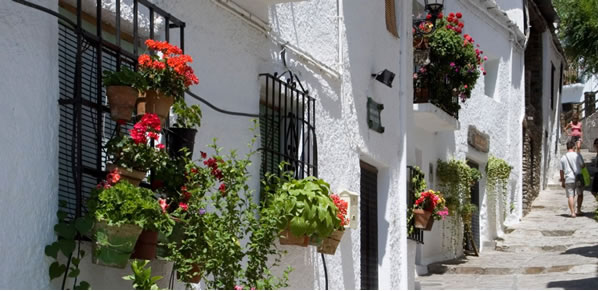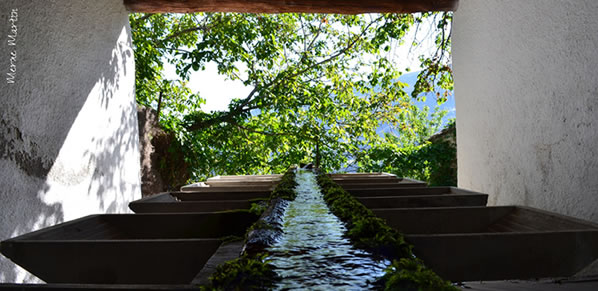SURROUNDING
PLACES OF INTEREST
The Alpujarras offer multiple alternatives for your free time. Surrounded by nature and being many of its municipalities in the Natural Park, it is the ideal place to practice all kinds of sports such as rafting, canyoning, paragliding, bungee jumping, hang-gliding ...
It is also tremendously easy to find numerous hiking routes, walks, bike routes or even horseback riding routes. Our hotel is an official information point and we can provide detailed information coordinated to carry out these activities, allowing our clients to enjoy the surroundings of the Sierra Nevada Natural Park.
Getting lost in Capileira streets
To really know the true Capileira and its people spirit we recommend to all visitors to explore the village. You will discover the magic of a unique place. Its steep and twisted streets, the white houses, the “terraos” (typical Alpujarra roofs), the “tinaos” (typical Alpujarra outside ceilings), the conversations with its inhabitants ... will make you feel a special peace.
Getting to the low part of the village (Fuente Hondera) is like taking a trip back in time, where you can experience the harmony between the human being and the geographical environment. The inhabitants of Capileira have been characterized throughout history by a scrupulous respect to the nature, where they live.

Pedro Antonio de Alarcón Ethnological Museum
It is located in the House of Culture. Farm implements, crafts, textiles, as well as some seventeenth-century carvings and a series of lithographs from the same period in which Pedro Antonio de Alarcón made his trip through these lands, are exhibited.
Visiting hours: from 11:00 to 14:30 hours, except Monday
Iglesia de Ntra. Sra. de la Cabeza
The church of the Lady of the Head It is part of the temples that the Catholic Monarchs built to convert the Moors to Christianity. The works began in 1,503 in the place occupied by the Muslim mosque, but it was demolished in favor of the church, in 1767.
In its Mudejar style building, Ambrosio de Vico intervened by the order of the archbishopric. It has a single nave and contains a seventeenth-century altarpiece in polychrome wood. The image of the Virgin of the Head was donated to the Council of Capileira by the Catholic Monarchs. It stands out for being the only old building in the village with no remodeling, and built with an inclined roof of Arab tile. The latter is made up of wooden trusses. The structure on which it rests is formed by thick load-bearing walls (around 80cm) of stone taken with mud, with several buttresses.
Visiting hours: Hours of worship
Going Down to the Poqueira River
Following the road that leads to Eras de Aldeire, and after a quarter of an hour's walk, you reach the river that gives its name to the gorge: the Poqueira. The Poqueira River is, among all the Alpujarra rivers, the best used and the most productive in electric power terms. Its water come from the glacial cirques of its head where the lagoons of Río Seco, La Caldera, Aguas Verdes, Majano and La Caldereta are located.

Poqueira Shelter
It is located at the altitude of 2,500 meters above sea level, on the southern slopes of Sierra Nevada. It is on the left bank of the Mulhacén river, above its confluence with the Seco river, in the Hoya de Peñón Negro. It is a strategic point at the foot of the valley, under the Mulhacén, with a wonderful perspective to the northwest of Veleta and Cerro de los Machos peaks, and a great void of valleys on the south that collides with the Sierra de Lújar and the Mediterranean on the background. It has telephone, bar, drink and meal services, food, free kitchen, tap water, wood stoves, etc. It also has emergency equipment (first aid kit, emergency station, relief material, etc.).
Eras de Aldeire
If we follow the path that goes down to the river, shortly after leaving the urban core, we reach Eras de Aldeire. These two stone platforms were used time ago for threshing cereal (wheat, barley) that grew in the mountain terraces. The breeze was important to help separate the cereal.
They are no longer used for this mean. Plant growing took a back seat and plantations such as wheat have completely disappeared. But what the Eras maintain for sure are their views. Being on the other side of the village from where the viewpoint is, we can see the part of the mountain range that covers the houses from there.
Capileira Viewpoint
This is one of the most privileged places of the village as far as views are concerned. From its railings, and looking south, we can see the other two villages of the Poqueira gorge: first Bubión and below it, Pampaneira. On very clear days you can even see the African mountain range. If we look in the opposite direction, towards the north, we can see part of the Veleta, the opposite slope to the ski resort of Sierra Nevada.
Public laundry
The public laundries are vestige of other times. Capileira has two: one old and another more modern. One is under the Hondera fountain and the other under the Pileta fountain. The lack of running water in the houses forced women to go to these facilities to do the laundry. It is easy to imagine the animation of the place, where the obligatory appointment propitiated chatting, exchange of impressions, and controversy about the latest news.

Public fountains
Capileira is a village where natural water sources abound.Minister fountain
On the way to Capileira along the road, we find this fountain on the right. If you have to wash your car, this is a place where it is usual done.
Cold fountain
It is the next fountain on the road before entering the village. If you are going to drink from its water remember that this fountain honor its name…
Shotgun Fountain
Just in front of the Cold Fountain, in a small viewpoint inside the curve you can find this old fountain. It’s been almost waterless for years.
Calvary Fountain
At Calvary Square, which could be the center of the town, a fountain of the same name flows. Due to the depth through which its water passes, the water temperature does not vary excessively from winter to summer.
Cherry Fountain
In the middle of one of the steepest streets of the town, Calle del Cerezo -Cherry Street-, there is a fountain that shows the economic activity that the village had: next to the fountain we find a pylon for the animals, a water trough.Hondera Fountain
This fountain is in "El Tajo del Diablo"
Pool Fountain
If we go further down the park we can see a fountain that is practically at ground level, the source of the pool.


